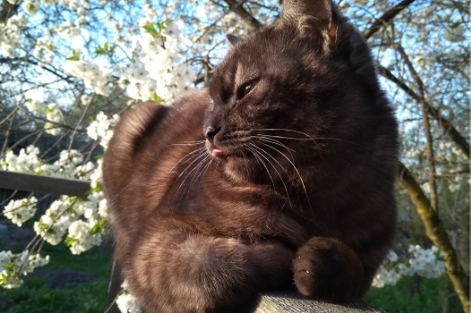According to Traditional Chinese medicine (TCM), each organ system of the body is associated with a season. Spring is the season of Liver and Gallbladder, where Liver is responsible for the smooth flow of Qi and Blood throughout the body all the way to the cornea and nails. Its counterpart, Gallbladder, ensures delivery of Qi to animate the limbs and give strength to stand. Liver also helps with the smooth flow of emotions and behaviors. Imbalances often seen in our companion animals are blood deficiency and liver Qi stagnation developing in many cases from poor digestion and inappropriate species diets. Signs and symptoms of blood deficiency can manifest as muscle spasms, dry itchy skin, alopecia, infertility, and impaired liver function. Behaviorally we’ll see heightened noise sensitivity, anxiousness, timidity, and nervousness. But these animals can overcompensate to prevent showing any weakness, becoming territorial. Liver Qi stagnation is often seen as abnormal muscle and nerve activity, often sharp and intense pain, to GI disorders including abdominal pain, vomiting, nausea, indigestion, and bloat. Example diseases include recurrent pancreatitis, gastrointestinal ulceration, and inflammatory bowel disease.
What can we do to help keep Liver balanced and flowing? TCM teaches us that eating according to the seasons can help alleviate symptoms naturally. Yet, for pets this is practically unheard of, much less encouraged. But, just as spring is about new beginnings, growth and moving outwards, it’s a perfect time to think about what you can do to improve and expand your feline or canine’s nutritional and lifestyle forays.
The color associated with Liver is green. How much greener can we get than spring fresh greens of lettuce, broccoli, kale, beans, and more? These offer powerful antioxidants and are packed with vitamins and minerals. Introduce slowly and know a little can go a long way for our pets. With cats, they’ll probably accept only a pinch – like the small bit that could be found in the stomach of their prey. With your dog you can add up to 10% of the meal. There are several pureed green products on the market, such as Primal Elixirs (for cats and dogs) and Green Juju (dog only). Better yet, try the Greens Stew recipe in the Recipe section of the blog.
Liver is nature’s most nutrient-dense superfood. Predatory animals eat organ meats first, instinctively knowing that they are a valuable source of nutrition. Many traditional cultures preferred organ meats to the lean cuts we generally eat today. An objection I’ve heard over the years is that the liver stores toxins, in reality, its job is to neutralize the body’s toxins. Those that aren’t eliminated most likely accumulate in fatty tissues and the body’s nervous system. What the liver does store are many important nutrients (vitamins A, D, E, K, B12, and folic acid, along with minerals of copper and iron). Whenever possible choose organ meats pasture-raised without hormones, antibiotics, or commercial feed for higher nutrient content.
For our pets, we can add a few commercial foods that incorporate liver or add a homemade recipe in your food rotation that uses liver. Try Basko Big Liver Stew for dogs and Premix Recipes for cats. Another fun way is to offer freeze-dried liver treats. Just be careful of their sourcing and limit the amount.
To prevent spring’s energies from getting out of control, it’s important to move and direct the dynamics. Take your dog for a long walk. Entice your cat into a session with a wand toy such as From the Field’s Freddy Feather wand, or supervise exploration outdoors for mental and physical releases. You can also talk with your holistic veterinarian about a spring acupuncture or herbal formula tune-up. Maybe have a session with a pet rehab specialist to show you stretches and massage to help muscle movement and conditioning. You might just find your companions benefit year-round!
© Terri Grow, 2021
Terri Grow writes and speaks on pet health and welfare, working with veterinarians, trainers, shelters and manufacturers to empower canine and feline health through diets, herbal therapies, supplements and environmental adjustments.






Leave A Comment